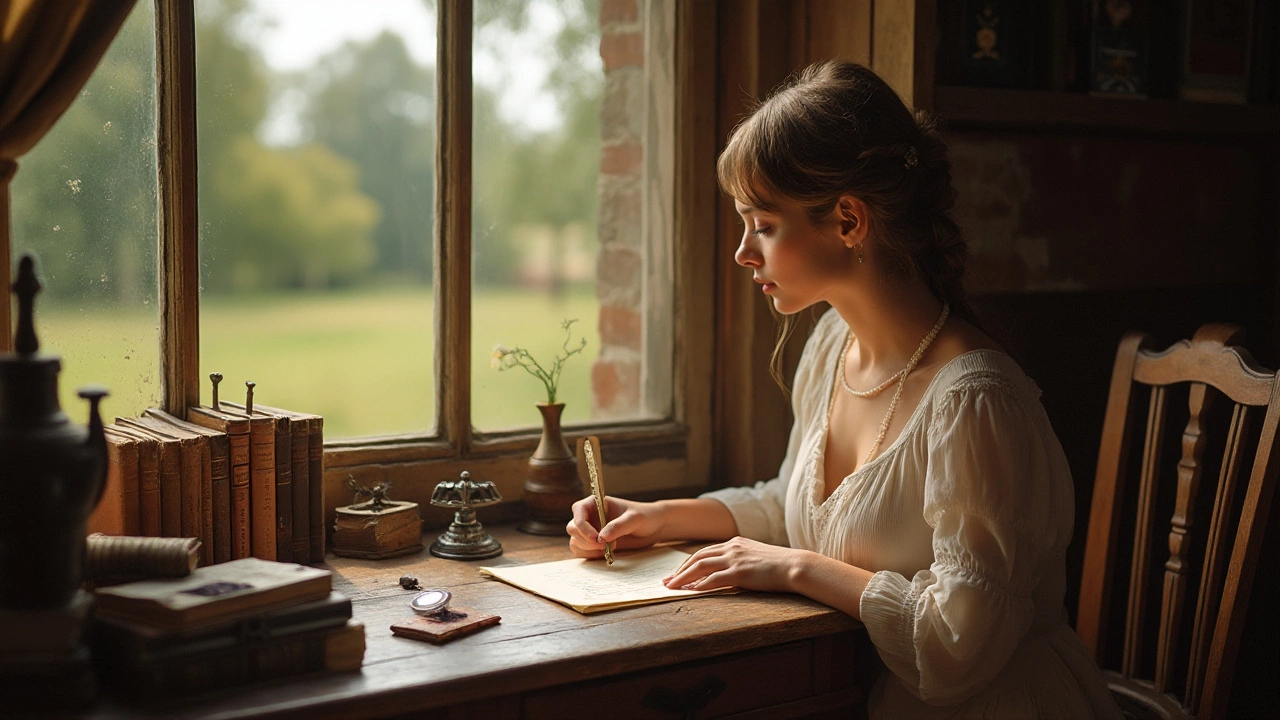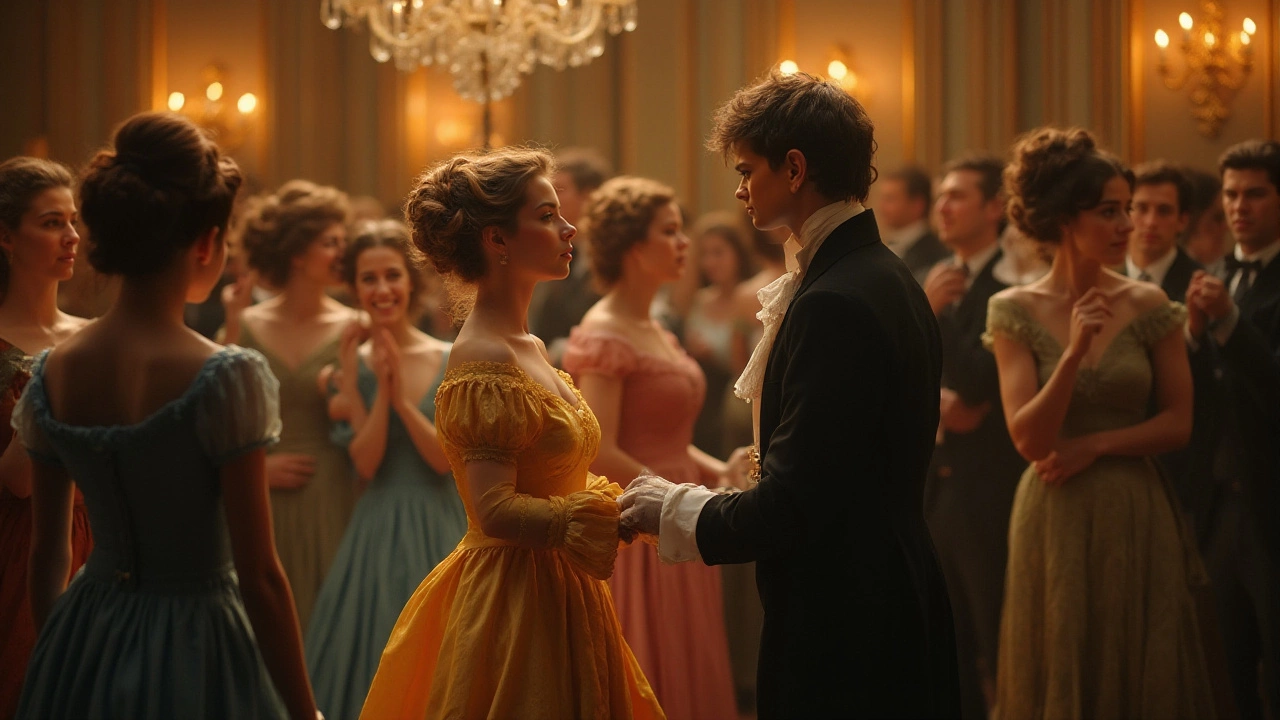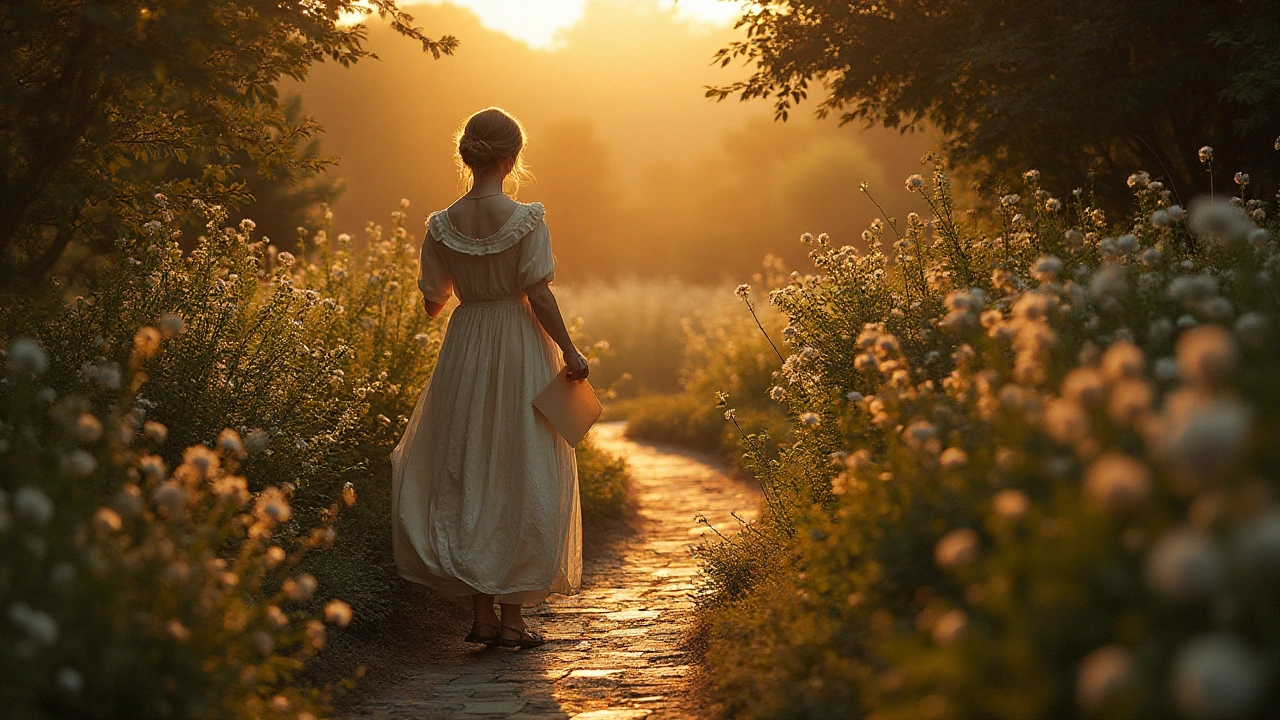Unveiling Jane Austen's Heart: Her True Love Revealed
 Jan, 13 2025
Jan, 13 2025
Jane Austen's love life holds a fascinating allure, much like the intricate romantic plots she weaved into her novels. Born in 1775, Austen's personal experiences have often been speculated upon and dissected by historians and romantics alike. Her letters and the accounts of those who knew her provide us with glimpses of a spirited woman who valued love and companionship deeply, yet navigated her life mostly in singlehood.
The tantalizing question remains: did Jane Austen harbor a deep affection for someone in her lifetime? Was there a figure who matched the passionate heroes she created on the page? As we dive into the intricacies of her relationships—with family ties, close friendships, and, of course, romantic entanglements—we hope to unveil what her heart might have longed for beyond her novels.
- Jane Austen's Early Life and Influences
- Rumors of Romance: Family and Friends Speak
- Tom Lefroy: The Most Famous Suitor
- Mysterious Harris Bigg-Wither Proposal
- Austen's Legacy of Love Through Her Works
Jane Austen's Early Life and Influences
In the quaint village of Steventon, Hampshire, in 1775, Jane Austen, one of the most celebrated names in English literature, was born into a world that would later serve as the rich tapestry for her storytelling. Her family was large, bustling, and filled with literary influences; thus, Jane’s early upbringing was instilled with a sense of creativity and intellect. The Austens were a lively, educated family, with her father, George Austen, serving as the rector of the local parish. He provided his children with a diverse library, a generous act that would spark Jane's lifelong love for the written word. The household's everyday conversation likely brimmed with discussions on politics, history, and literature, which exposed Jane to a wide range of themes and ideas.
Austen’s formal education was initially undertaken alongside her sister, Cassandra, at boarding schools. Both girls received an education typical for their social standing, which imparted basic skills like reading, writing, and sewing. However, it was the informal, self-driven study at home, largely under the guidance of her father, that truly shaped her intellect and inspired her creative pursuits. The Austen children wrote and performed their own plays, a formative exercise for young Jane that honed her narrative instincts and stimulated her imaginative faculties. The vibrant interaction with her siblings and parents deeply impacted her understanding of human nature, social dynamics, and emotional complexity, which became the hallmarks of her novels.
Apart from her family, the countryside and its social ecosystem also left a mark on young Jane. The vivid landscapes, local gentry, and the intricate web of social manners provided the raw material for her vivid portrayals of English provincial life. As a child, Jane was an astute observer of people and events around her, which is perhaps why her characters are drawn with such captivating authenticity. Jane Austen's penetrating insights into human nature, her satirical yet affectionate observations of her society, often reflected the microcosmic world she inhabited in her early years. Her brother, Henry Austen, famously remarked,
"Her life was below the surface, in the depth of her mind where she attended to the dictates of her genius."This profound interior world, nurtured by a rich familial and social environment, sowed the seeds of her future literary masterpieces.
Even in the early 18th century, the conditions that the Austen family faced—modest living with notable social connections—illustrated the era's complexities that Jane would later dissect in her writing. Those formative years, flavored with love, laughter, and an occasional whisper of genteel poverty, infused her stories with realism and charm. Balancing the whims of society and the delights of imagination, Austen turned her early influences into fodder for novels that explored themes of love, morality, and societal expectation. As we peer into Jane Austen's formative years, we uncover the profound imprint they left, providing storytellers and scholars alike with clues as to who this enigmatic author truly was, and what undercurrents shaped her compelling tales.
Rumors of Romance: Family and Friends Speak
When it comes to Jane Austen, history's favorite enigma of romance and intellect, much of what we know about her personal romantic life comes from candid accounts provided by her family and immediate circle. Her elder sister Cassandra, to whom Jane was particularly close, was a significant figure in cataloging the intimate details of Austen's life—both through preserved letters and shared reminiscences. These letters, although somewhat limited as Cassandra destroyed many of them, offer tantalizing insights into potential romantic interludes that Austen may have experienced, including her possible affection for Tom Lefroy, a dashing young Irishman she danced with during a ball season. Their flirtation, infamously brief, endured in literary lore, sparking imaginations about the man who perhaps represented a real-life romantic novel. Their encounters were spirited, yet societal notions and familial expectations of the period seemingly curtailed any potential for serious engagement.
Besides Lefroy, other figures floated within the periphery of rumor and whisper during Austen’s lifetime. Friends and kin often speculated about the mysterious figure known simply as the clergyman to whom Jane reportedly became attached during a seaside holiday. Though his identity remains largely enigmatic and unconfirmed by historical records, family anecdotes recount tales of mutual interest and an undercurrent of something more profound, later disrupted by his sudden death. The Austens, particularly via letters preserved by extended relatives, narrate these stories not as mere romantic folly but rather relationships tinged with genuine if restrained emotion, reflecting the societal corridors through which eligible women of Austen's standing navigated. Notably, Austen's works exhibit characters facing similar constraints, suggesting how her personal experiences potentially influenced her narratives.
"Her love of her home and immediate family was the strongest affection of her mind," asserted by Jane’s nephew James Edward Austen-Leigh in his memoir 'A Memoir of Jane Austen,' offering a nuanced view into her closest emotional ties. Yet it begs contemplation: was family the ultimate anchor in Jane's affections, or rather the robust scaffold that supported unarticulated romances?Interestingly, some family members posthumously claimed she had refused at least one if not more possible proposals, valuing her independence and literary pursuits. This blend of choice and circumstance suggests why, despite her apparent lack of matrimonial motivation, Austen's heartfelt yearnings shone through her novels' pages, casting complex narratives on romantic fulfillment.
Modern researchers delving into Austen's life have also highlighted interactions with her extended circle, which included the well-to-do and strategically well-placed friends who would have known and potentially courted an affable and witty lady like Jane. These characters, while not lifted directly into her famed works, may have inspired the sort of companions that populated her written worlds. Despite the whispers and the blurring lines between real and speculated suitors, Austen inspires continued interest precisely because her innermost romantic truths remain shadowed, their substance being reflections glimpsed through anecdotes and the powerful emotional currents in her literary masterpieces.

Tom Lefroy: The Most Famous Suitor
Among all the figures that graced Jane Austen's life, Tom Lefroy stands out as a compelling character who might have once captivated her young heart. Born in 1776, Thomas Langlois Lefroy was an Irishman with ambitions and the vigor typical of someone at the cusp of adulthood. He and Jane Austen encountered each other during the Christmas holidays of 1795-96 when Lefroy visited relatives near the Austens’ home in Hampshire. This period of acquaintance was marked by a flurry of social gatherings where dances and conversations provided young people of marriageable age the opportunity to mingle and connect.
Jane's correspondence with her sister Cassandra offers a rare window into her sentiments at the time. She mentions a distinct admiration for Lefroy's charms and intellect—qualities she often attributed to her romantic heroes. Though these letters are playful and tease about her flirtations, they also hint at a deeper fondness. Austen writes of being 'almost engaged' to Lefroy, although this was likely spoken in jest.
"He has but one fault, which time will, I trust, entirely remove—it is that his morning coat is a great deal too light," she humorously penned, offering a glimpse of affection concealed beneath jests.1
The Short-Lived Romance
The excitement surrounding Jane and Tom's interactions, however, met the inevitable constraints of social class and familial duties. Both individuals were expected to marry wisely rather than recklessly, considering financial stability and social standings paramount in 18th-century England. Lefroy's family was particularly insistent that he pursue a match which promised financial security, a priority evident when he left to further his studies in London shortly after the holiday encounters with Jane.
As time went on, Lefroy rose to prominence as a lawyer and ultimately became the Lord Chief Justice of Ireland. Despite the brevity of their acquaintance, the memory of those days seemed to linger. In Austen's works, especially when considering the themes of unrequited or complicated love, one might wonder whether characters like Mr. Darcy or Captain Wentworth owe their emotional depth to what she once felt, or imagined feeling, for Tom Lefroy.
Whether Jane Austen indeed viewed Lefroy as a true love or merely an infatuation is a subject of ongoing debate. What remains clear is that the youthful sparkle of that season left its mark on Austen’s imagination, possibly influencing the romantic canvases she so masterfully painted in her novels. Their fleeting story serves as a testament to the power of early love and the perennial question of 'what might have been' that so often fuels romantic novels. This tantalizing chapter in Jane's life adds a touch of reality to her fantastical tales, showing that even someone as skilled in dissecting human emotion as Austen might have had her moments of genuine affection and longing.
Mysterious Harris Bigg-Wither Proposal
The proposal from Harris Bigg-Wither to Jane Austen is a fascinating topic steeped in the mystery of what might have been. In December 1802, with the chill of winter creeping into the Hampshire countryside, Jane and her sister Cassandra visited Manydown Park. It was during this visit that Harris, a well-off but reportedly somewhat dull man, proposed marriage. The offer was surprising, not least because Jane, already in her late twenties, was considered somewhat past the typical marrying age of her time. Acceptance would mean a life of comfort, but Jane’s heart had different notions.
Despite the pragmatic benefits of the match—security and perhaps a chance to settle some financial worries—Jane initially accepted the proposal. The news startled those who knew her, speculating whether the acceptance was coaxed by familial expectations or a moment of self-doubt. Yet, as the dawn of the next day broke, Jane’s restless mind led her to reconsider. The passionate spirit that allowed her to pen stirring romances was at odds with a future promised to lukewarm affection. Without delay, Jane retracted her acceptance, leaving Manydown Park and Bigg-Wither behind. This decision paints a picture of Jane as fiercely independent and committed to living life on her own terms, despite the social conventions of that era.
Reflecting on this incident, scholars often wonder about its implications for Austen's craft. Did this brief engagement influence her novel’s endings, where love blends with mutual respect and admiration? Her decision to refuse comfort hints at an emotional courage traced through her heroines. In truth, the years after returned her to being a writer with her best works still ahead. One might argue that this decision was a pivotal moment in her life. A path diverged into dedication to her art over an ill-suited partnership.
"She had given him her hand, but not her heart," muses scholar Margaret Forster in her analysis of Austen’s life choices, underscoring the depth of this decision.It is not just a tale of a broken engagement but a testament to Austen’s unwavering commitment to staying true to herself.

Austen's Legacy of Love Through Her Works
Jane Austen left an indelible mark on the literary world with her nuanced depiction of love and societal norms. Her novels continue to resonate with readers because they blend rich characters with heartfelt storytelling. Austen's portrayal of love is neither overly sentimental nor purely practical; instead, it dances on the delicate line between genuine affection and societal expectations. Her most celebrated works, like 'Pride and Prejudice' and 'Sense and Sensibility,' highlight the complexity of romantic entanglements, while also offering astute commentary on the social structures of her time. Through characters like Elizabeth Bennet and Elinor Dashwood, she explores the trials and triumphs of love in a way that both challenges and captivates the reader, ensuring her legacy as a beloved novelist endures.
While the romantic dynamics within her novels are captivating, it's essential to understand the context in which Austen wrote. Living in a society where marriage was often viewed as a necessity rather than a choice, she skillfully critiques the pressures exerted upon women to secure an advantageous marriage. Her writing does more than weave engaging tales; it provides profound insights into the paradoxical natures of love and duty. One could argue that *Persuasion* perhaps serves as her most mature take on the romance framework—the story of Anne Elliot and Captain Wentworth illustrates themes of second chances and enduring love, underscoring Austen's belief in the redemptive power of time and communication.
An Enduring Impact on Romantic Literature
Jane Austen's influence on the romantic genre is immeasurable, and her narratives have inspired countless adaptations and imitations across various media. Her pioneering exploration of character-driven romance set a high standard that authors continue to emulate. The strife and resolution found in her stories speak to universal truths about the human condition, making her works timeless. Contemporary romantic authors often cite Austen as an inspiration, noting the profoundness with which she captured emotional authenticity. This ability to authentically render the complexities of love is what cements her work in the canon of classical literature.
Beyond the structural and character-driven elements, Austen's educational background and societal observations lend credibility to her narratives. Her novels are richly rooted in her exquisite understanding of class dynamics and human psychology. This stellar combination of realism and romanticism ensures her stories not only entertain but also provoke thought and reflection.
"It is a truth universally acknowledged, that a single man in possession of a good fortune, must be in want of a wife." – Jane Austen, *Pride and Prejudice*This opening line captures her wit and ability to critique societal norms with grace, an art that remains unmatched to this day.
Bridging the Gap Between Reality and Fiction
Perhaps the most captivating aspect of Austen's work is her ability to blend reality with fiction effortlessly. Her characters are deeply relatable, often reflective of people in the actual social hierarchies of her time. She uniquely intertwines fact with imaginative flair, giving readers a mirror to the era's social fabric. Themes of love, resilience, and personal growth are interspersed with subtle humor and irony, challenging and entertaining her readers in equal measure. The fact that her works continue to inspire numerous film adaptations, demonstrates the lasting power and appeal of her storytelling.
Unraveling Jane Austen's legacy reveals a tapestry not only of personal artistry but also of cultural history. She remains a touchstone for those exploring the depths of romantic fiction. Her novels offer a gateway into understanding the period's societal pressures while inviting us to reflect on our interpretations of love and happiness. As long as there are those who appreciate the beauty of literary romance, Austen's works will continue to illuminate the intricate dance between love and society.